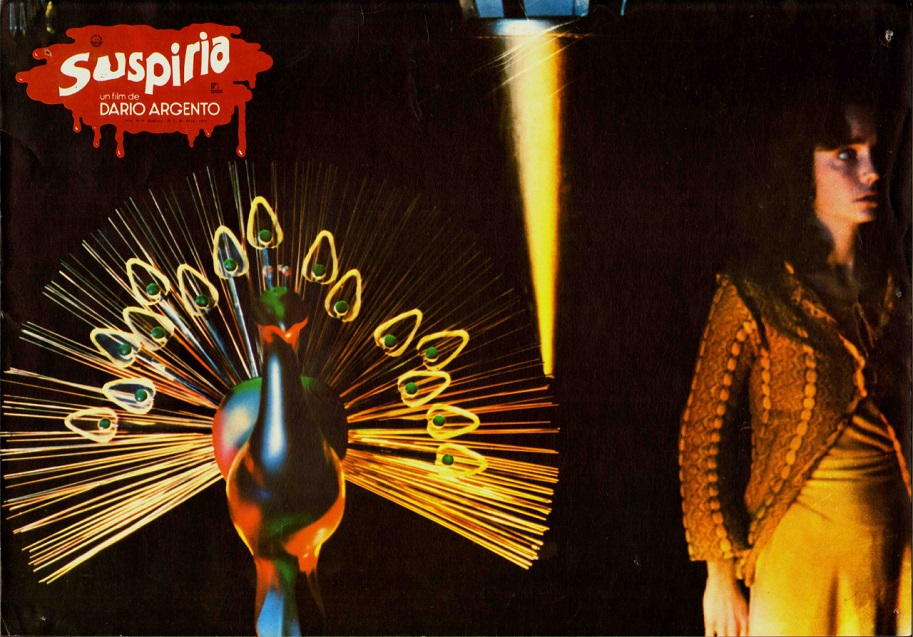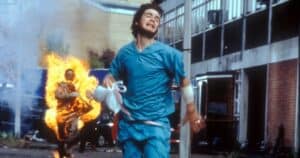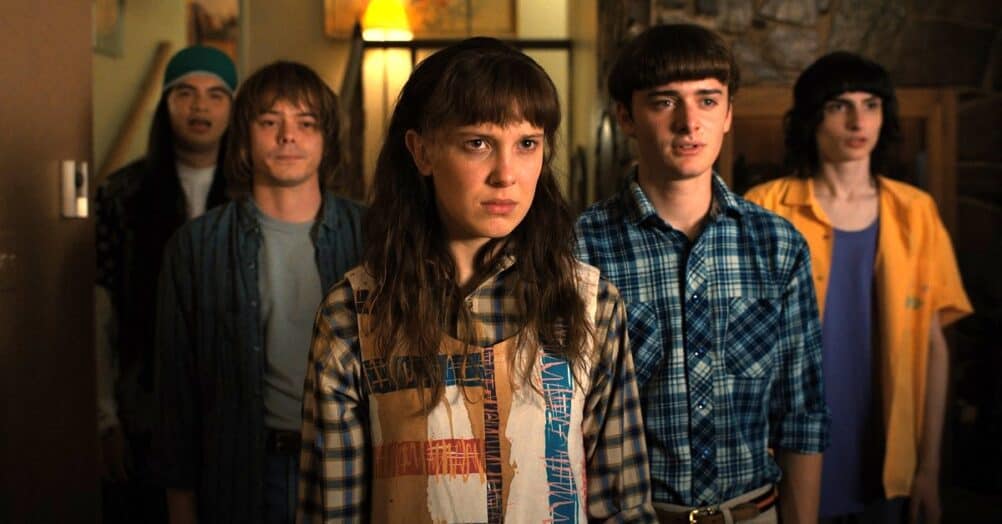Last Updated on August 2, 2021

We all have certain movies we love. Movies we respect without question because of either tradition, childhood love, or because they’ve always been classics. However, as time keeps ticking, do those classics still hold up? Do they remain must see? So…the point of this column is to determine how a film holds up for a modern horror audience, to see if it stands the Test of Time.

DIRECTED BY DARIO ARGENTO
STARRING JESSICA HARPER, UDO KIER, JOAN BENNETT, STEFANIA CASINI, FLAVIO BUCCI
On a scale of 1-10, how stoked are y’all to see Luca Guadagnino’s SUSPIRIA when it opens wide on November 2nd? No bullshittin’, I’ve been on record saying it’s my personally most anticipated horror joint of the fall (stay tuned for a review soon), and damn if it didn’t disappoint! Of course, when you remake a movie so famously beloved by generations of fervent horror fans across the globe (ranked 18th on Entertainment Weekly’s 100 Scariest Movies, 24th on Bravo’s 100 Scariest Movie Moments, listed in Steven Schneider’s 1,001 Movies You Must See Before You Die, etc.), a movie that is most associated with the splendor of Italian splatter maestro Dario Argento, expectations are almost unfairly raised to the nth degree. But that’s for another day (perhaps in an Original vs. Remake article).
Today however is all about zeroing in on Argento’s 1977 masterstroke of malefic menace, and using that same high bar of expected meritorious luster applied to the redo, we plan to reassess a film that has held as the paragon of Italian horror for 40 years, with as fresh eyes as possible. As in, I just revisited this sucker last night! Strap in ladies and gents, we’re fin to find out if SUSPIRIA is still the superb spellbinder it was four decades ago. The Test of Time is nigh!

THE STORY: Co-written by Dario Argento with his then girlfriend and frequent collaborator Daria Nicolodi, the story of SUSPIRIA (which means “sighed” or “whispered”) was inspired by real life tales the latter shared with the former. Meaning, Nicolodi’s grandmother used to tell her about the time she fled a German music academy because wicked witchcraft was being furtively conducted there. True or not, it was good enough to set Argento off in following up DEEP RED, which still happens to be my favorite Argento title to date. Similarly, the specifics of the finale, which we’ll touch on below, was also inspired by a nasty nightmare Nicolodi once had, in which she witnessed an invisible witch. All fertile ground and gnarly starting points for, which Argento actually wanted to appropriate in a far bolder and more brazen manner by originally envisioning the Tam Academy housing young female dancers no older than twelve years. Of course, producers balked at that idea, noting that such a viciously violent movie involving children would surely be outlawed. Even so, Argento never retooled the script aside from changing the ages from 12 to 20. This would account for some of the childish, naïve, immature actions and decisions made by many of the characters along the way.
Now let’s get specific. As the film opens, Suzy Bannion (Jessica Harper) arrives in Berlin from New York, only to be met by a violent rainstorm, howling winds and fulminating lightning strikes. The atmosphere is properly established in the first two minutes. When Suzy arrives at the Tam Dance Academy, she is instantly alarmed to see a harried woman named Pat Hingle (Eva Axen) flee the academy in horror, making her way into the woods. The next morning, Suzy learns Pat has been gorily vitiated by a mysterious interloper. When she tells headmistress Madam Blanc (Joan Bennett) of what she saw, she’s slyly brushed off and told not to worry too much. After falling into a dizzy spell, Suzy comes to and finds a harem of crusty old harridans forcing water down her throat. Shit’s getting awfully odd at the Tam Academy.

Soon, the only real person Suzy can turn to is Sara (Stefania Casini), who begins to fill her head with notions of subrosa witchcraft being practiced in the academy. A few more mysterious murders follow suit, and soon a young and dashing Udo Kier as Dr. Frank Mandel exposes a nefarious agenda that has been in place for years at the academy. A witch named Helena Markos (the uncredited Lela Svasta, who Harper claims was a 90 year old street hooker Argento found last minute), aka the Black Queen, founded the academy in 1895 and held occult rituals until she died in a fire in 1905. Her number one pupil kept the academy running, operating a dance troupe as a front for the sick and sinister shenanigans to persist. Of course, poor Suzy (does anyone else think Harper looks like Karen Allen minus the freckles?) is caught in the accursed crosshairs!
WHAT HOLDS-UP: While detractors like to point out that the aforementioned storyline of SUSPIRIA does not hold up, as it was disjointedly nonsensical to begin with, having just seen it again last night, I can say the overall experience of SUSPIRIA has certainly endured far greater than it has aged. Many qualities account for this, but as we often like to boil the recipe down to a trio of ingredients, we’d say the following are what absolutely holds-up most in SUSPIRIA: the sights and sounds, the disorienting surrealism, and the grisly outbursts of gore-laden violence. Dig in below to see what we mean!

Straight up, the colorfully off-kilter imagery of SUSPIRIA is beyond reproach. The candy-colored neon lighting, the sumptuous sets and ornate architecture of the Tam Academy, the spatially vertiginous choreography within the walls of the place…they all fuse together to create one of the most simultaneously beauteous yet baleful surroundings one can recall in a horror film. The neon greens, hot pinks, cold blues, deep reds, velvet purples…Argento employs a psychedelic array of dazzling imagery that cuts right to the psychological unrest experienced by us, the viewer, as seen through our curious conduit, Suzy. From the portentous moment we first see this mood-inducing rainbow effect in the first shots of the film, we instantly know something is slightly off, something isn’t quite right. You can’t quite articulate it or put your finger on it, but something is most certainly unlawful about the whole thing.
Many believe that the film rich luster and vivid colorings must have been achieved by filming using the three-strip Technicolor. This is not the case, as no film shot on Technicolor after the mid 1950s. Instead, Argento and DP Luciano Tovoli (BREAD AND CHOCOLATE, THE PASSENGER, TENEBRE) shot the film on normal Eastman Kodak film stock, then printed using one of the last remaining 3-strip Technicolor machines. Following the film, Technicolor Rome destroyed their 3-strip equipment. Now, when you overlay these images with the inimitable sounds of Goblin’s infamous film score, which was co-conducted by Argento himself, a doubling effect takes hold. The twinkly, droning, hypnotic score that plays almost wall-to-wall throughout the film has a trancelike affect that reinforces the same lulling imagery seen onscreen. This is a perfect marriage of sight and sound, which not only complement each other, but ultimately synthesize the movies other enduring quality – which is the disorienting surrealism!

Truly, what impresses most about SUSPIRIA when watching it today is just how wildly surreal and nightmarishly canted the whole endeavor feels while watching it. The sights and sounds contribute to it mostly, but it’s also the way in which Argento frames his action, leaks bits of info through cryptic dialogue, and always keeps the audience stumbling along with two left-feet. You simply cannot get good footing or firm grip on what is happening in the movie, which lends itself to a kind of disorientation Hitchcock (VERTIGO), Polanski (REPULSION) and Kubrick (THE SHINING) were able to achieve in their heyday. And frankly, sights and sounds so antithetically surreal to what we’re used to seeing in reality are downright terrifying. They were in 1977, and remain so in 2018!
Now let’s get gory, shall we. You know we’d be remiss not to mention the handful of homicidal horrors seen in SUSPIRIA, particularly when a few of them remain some of the movies stronger points. The opening fatality, in fact the first fifteen minutes of the movie, is absolutely masterful. Pat returns to the academy after darting through the woods away from a threatening force, only to be attacked through her second-story bedroom window, stabbed in the naval many times over with a pocketknife, before being systematically strangled with a power-cord until her gory corpse hangs from the lavish Art Deco ceiling as a faucet of grue rains down below. The stunning visuals here are amped twofold when, as the aftermath shows, another unsuspecting woman has her crotch and trachea impaled by a tripod, her face brutally bifurcated by a giant glass shard. Punctuating the surrealism is the thick coat of rich red blood, consistent with a can of paint. While this sequence comes early in the film, it still remains one of its most potently memorable images!

In other enduring example of blending surrealism with violence comes via Sara’s death. Like a fly trapped in a spider’s web, the poor girl finds herself falling into a coiled network of barbwires, where she writhes futilely, entangling herself even further witch each desperate movement (apparently Casini was really injured by the set, as the fake barbwires still painfully pinched her skin). Soon a killer slices her throat in close-up, a requisite pour of goopy gore leaking out. We could also address Daniel’s (Flavio Bucci) deadly dog attack, but doesn’t quite hold up as well as the f*cked up finale does. So let’s skip there instead.
Just as the first 15 minutes of the film set the stormy atmosphere for things to come, the final 15 minutes comes full circle to give us an equally show-stopping display. The lightning strikes down once more as Suzy finally locates the secret lair the footsteps she’d been hearing lead to. The rain intensifies. The soft glow of the neon interiors shine back up. Suzy saunters through the abandoned academy as the hypnotic Goblin score slowly wells up. She traverses a baroque hallway, eventually stumbling on the clandestine coven of witches, Madame Blanc among them. A ritual is in place. The neon colors strobe into the rainbow effect. Suzy spots Sara’s desecrated carcass, yelping at the sight until she’s discovered. Suzy grabs a glass quill from THE BIRD WITH THE CRYSTAL PLUMAGE and plunges into the invisible witch. Then, in an explosive crescendo, every object in the room shatters to pieces (note the porcelain panther, which was part of Nicolodi’s inspirational nightmare. She saw a panther in the room with the invisible witch, and for whatever reason, the panther exploded in her dream). A head-spinning whirlwind ensues until Suzy finally braves the elements and hightails the f*ck out of dodge!

WHAT BLOWS NOW: We mentioned how the jumbled story and confusing plotlines have irked many in the past, but when considering what does not work now, it’d be hard to defend the slow middle section of the movie. For a flick that is only 92 minutes long, the languid pacing of the second act really does protract the overall experience. I’m actually okay with this, as it kind of work in favor of the hypnotic quality the movie adheres to, but there’s no doubt the best parts about SUSPIRIA are the beginning and ending. The middle isn’t bad enough now to detract from the opening and closing, but it still a bit of a slog.
THE VERDICT: SUSPIRIA has remained a horror classic for over 40 years for a reason. Many reasons actually, and chief among them are the sights and sounds Argento so beautifully and hauntingly captured onscreen with DP Luciano Tovoli and Gothic rock band Goblin. The sense of surrealistic disorientation Argento achieves is a direct result of those very sights and sounds, and both aspects are augmented by the highly stylized stints of violence. All things considered, for as inherently evil as it is, SUSPIRIA still boasts more good than bad!



















Follow the JOBLO MOVIE NETWORK
Follow us on YOUTUBE
Follow ARROW IN THE HEAD
Follow AITH on YOUTUBE